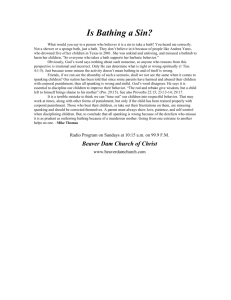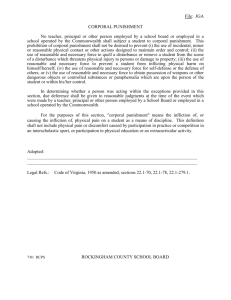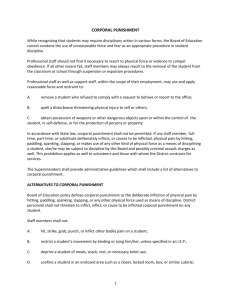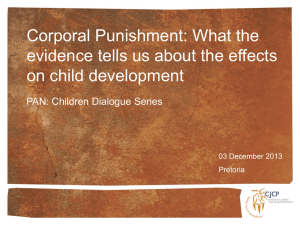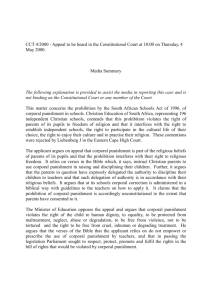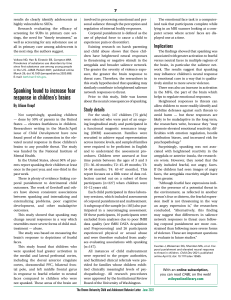Document 10958868
advertisement
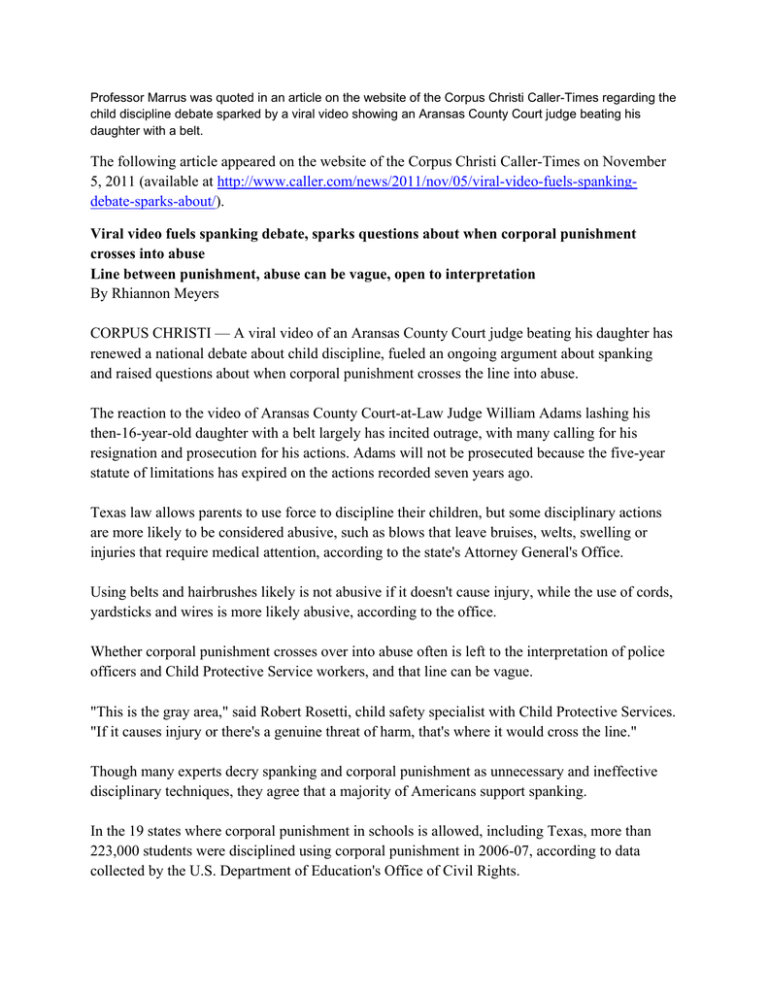
Professor Marrus was quoted in an article on the website of the Corpus Christi Caller-Times regarding the child discipline debate sparked by a viral video showing an Aransas County Court judge beating his daughter with a belt. The following article appeared on the website of the Corpus Christi Caller-Times on November 5, 2011 (available at http://www.caller.com/news/2011/nov/05/viral-video-fuels-spankingdebate-sparks-about/). Viral video fuels spanking debate, sparks questions about when corporal punishment crosses into abuse Line between punishment, abuse can be vague, open to interpretation By Rhiannon Meyers CORPUS CHRISTI — A viral video of an Aransas County Court judge beating his daughter has renewed a national debate about child discipline, fueled an ongoing argument about spanking and raised questions about when corporal punishment crosses the line into abuse. The reaction to the video of Aransas County Court-at-Law Judge William Adams lashing his then-16-year-old daughter with a belt largely has incited outrage, with many calling for his resignation and prosecution for his actions. Adams will not be prosecuted because the five-year statute of limitations has expired on the actions recorded seven years ago. Texas law allows parents to use force to discipline their children, but some disciplinary actions are more likely to be considered abusive, such as blows that leave bruises, welts, swelling or injuries that require medical attention, according to the state's Attorney General's Office. Using belts and hairbrushes likely is not abusive if it doesn't cause injury, while the use of cords, yardsticks and wires is more likely abusive, according to the office. Whether corporal punishment crosses over into abuse often is left to the interpretation of police officers and Child Protective Service workers, and that line can be vague. "This is the gray area," said Robert Rosetti, child safety specialist with Child Protective Services. "If it causes injury or there's a genuine threat of harm, that's where it would cross the line." Though many experts decry spanking and corporal punishment as unnecessary and ineffective disciplinary techniques, they agree that a majority of Americans support spanking. In the 19 states where corporal punishment in schools is allowed, including Texas, more than 223,000 students were disciplined using corporal punishment in 2006-07, according to data collected by the U.S. Department of Education's Office of Civil Rights. While more than 30 countries have banned corporal punishment, Americans believe strongly in the privacy of the family, and that what goes on behind closed doors is not the business of the state, the federal government or neighbors, said Ellen Marrus, co-director for the Center for Children, Law and Policy at the University of Houston. "In the U.S. we want to be able to discipline our children as we like," said Jackie Nelson, an assistant professor in the University of Texas' Dallas School for Behavioral and Brain Sciences. Nelson said the research on spanking also is mixed likely because spanking has a different meaning to different people. Judge Adams has described his lashing as discipline and said the video is not as bad as it appears. Others reacting to the video have disagreed. Local radio host Jim Lago, who was inundated with calls about the video Thursday, said callers overwhelmingly were outraged by the judge's actions, though a few expressed concerns about allowing the state to regulate how parents discipline their children. Lago said he thought the video portrayed rage and violence, not discipline. "I didn't really see corporal punishment going on," he said. Experts generally agree there's a fine line between a swat on the butt and more serious disciplinary practices, particularly when parents administer it in rage and frustration, said Elizabeth Gershoff, associate professor of the Department of Human Development and Family Sciences and Population Research Center at the University of Texas. "There's a slippery slope between hitting them with a hand and an object, and hitting them twice and hitting them 10 times," she said. "It all has negative consequences for children, and it's too easy for spanking to get carried into abuse." Parents never should discipline at the height of their anger, and instead delegate the punishment to a more coolheaded family member, Rosetti said. A flick of the wrist is all the force needed to appropriately spank a child, according to Focus on the Family, a global Christian ministry. The goal is for a spank to sting, not injure, according to the organization's parenting article. Officials there could not be reached for comment. "A parent who reaches back and swings hard is acting out of anger and frustration, not out of love and desire for the child's welfare," the organization states. "That's unbiblical by anyone's definition." Parenting skills Research psychologist Robert Epstein, who has written 15 books and developed a parenting test, said he is perhaps one of the only experts in his field who believes that corporal punishment is appropriate in rare occasions, such as when a child engages in repeated dangerous behavior like playing with matches or running into the street. However, he said spanking in general is poor parenting that often is more of an expression of a parent's frustration rather than good discipline. Epstein, who has six children, said he believes parents turn to corporal punishment because they aren't aware of less risky forms of discipline. He said that lack of education was apparent when, in a course he taught for licensed clinical psychologists, he asked them to list all the ways to suppress bad behavior in children. Most could only conjure two or three ways, including corporal punishment. In his course he taught 50 techniques. "The more you know about parenting, the less corporal punishment pops into your head," he said. The lashing portrayed in Hillary Adams' video is much more severe than the spankings most parents dole out, but nonetheless, hitting children is problematic, ineffective and potentially damaging, Gershoff said. Effects of spanking After 15 years of studying the effects of spanking, she has found that in the short term, children are less likely to comply with their parents' requests nor behave. In the long term, spanking can lead to behavior problems, such as aggression or delinquency, or fractured relationships between child and parent. "It's hard to trust and feel close to someone who hits you," she said. Gershoff, who said she never has spanked her children, said she questions the social perception that it's OK to hit children, but not others. "Hitting an adult is assault," she said. "Why is hitting a child not an assault? If (Adams) had been doing that to any other person, he would've gone to jail for sure. If he had done that to his wife, a neighbor's child, somebody he met at a bar, anyone he did that to, it would've been assault." And while many people see Adams' actions as isolated, Gershoff said it's far too easy for an enraged parent to have a similar violent outburst. "Most people say, 'I don't do that. That's not me,'" she said. "But what they don't realize is, it could be them. We are all bigger and stronger than our children are. So hitting them can always damage them and always be traumatic for them, either physically or mentally." Gershoff, who also believes that timeout is typically ineffective, said effective punishment is tied to the offense. Parents can discipline children who write on the wall by forcing them to wash it and taking away their crayons. A kid who runs in the street should be confined to play in the house for the day. A teenager who breaks curfew isn't allowed to go out the next weekend, she said. If nothing else, the video has sparked discussion about child abuse, and could lead to a greater awareness of the subject, said Robert Bell, children's justice coordinator for Childhelp, an organization dedicated to the prevention and treatment of child abuse. The organization has featured Judge Adams' story on its home page. "What we might see in public that might alarm us is probably minimal compared to what's happening behind closed doors," he said. "This video is very powerful because it does give the public a glimpse of what can happen behind closed doors."
